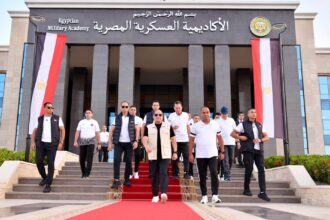The residents of 7, Nubar Street in Downtown pin their garbage bags to the wall so that the stray cats do not litter the stairwell. But the feline species have found a less acrobatic means of procuring food on the 11th floor, a space they share with nine artists. A particular cat the artists named Studio, has come to embody the essence of this new project.
The Rooftop Studio Project is the brainchild of Townhouse Gallery’s Director William Wells, who as early as 2007 envisioned hosting a space where artists would work and mingle with peers. An artist-run initiative, the Rooftop finally came to being this year, funded by the Goethe Institute and Dutch embassy with the Townhouse Gallery.
The studio is “better than we thought, Rooftop coordinator Ahmad Hosni told Daily News Egypt. The 750 square meter space has eight rooms as well as two communal work areas; with outdoor, indoor and individual workspaces.
“It’s more than just a space to work. A professional photographer, Hosni prefers the creative and interactive atmosphere of the studio. While currently working on his book on Sinai, photos of which line his walls, he shares his room with two other visual artists.
“I used to live a reclusive life, said Hosni. The rooftop, in contrast, allows him an opportunity to mingle with artists from backgrounds different from his own.
The artists rent the studio space for LE 150 per month; the only requirement is that they show up and use their work space.
Sharing the space has also informally led to joint work between artists.
Tessa Lewin and Essam Abdallah, for example, are currently working on an animation project together.
Ideas float around and are shared as swiftly as cigarettes in the studio.
Abdallah reveals that writer and illustrator Ayman Farag recently bought a drafting table having seen Abdallah’s in the studio. The studio has wireless internet, which is also useful for research purposes. Visual artist Mohamed Abdelkarim explains that he has benefited by learning technical skills from other artists in the studio.
In a trail of seven pieces of paper on the wall he shares with Hosni, Abdelkarim’s silhouette blends into a Kalashnikov. He spends a good 40 minutes discussing how militaristic icons – unappealing representations in themselves – define citizenship.
Having a “rooftop was an integral part of the vision, said Essam Abdallah, former coordinator who originally scouted and found the studio at its current location. As was overheard at the recent “Rooftop Party, no doubt putting those words together elicits a certain charm, especially in the thick summer heat. Yet the rooftop is far from a party venue.
“There are rules, both Hosni and Abdallah concur. These rules though are informal, a result of much experimenting. The studio is meant to be a working space. If rooms are empty, said Hosni, it may lead to eviction. “You are expected to use this space, said Abdallah, yet nothing else is expected of them.
Abdallah recalls all dates with clarity. He found the venue in November, occupied then by American University in Cairo students who were readying to leave the place due to the campus’ relocation.
While the studio was rented as early as February, it was only on March 23 that all artists assembled for a meeting; prior to that the studio was a little-used venue. And only following the May 1 barbecue party, a communal spirit was born where people “literally came in every day, Abdallah added.
A friendly and discursive environment, Abdallah said the studio was immensely conducive to his own work. Working to meet a deadline, he found himself able to work 48 hours nonstop.
“What kept me going was being here, said the artist, “people coming and going; people helping. Abdallah recalls being given a book by famed comic writer Alan Moore (“Watchmen, “V for Vendetta ) on writing comic books. “Everyone cares about everyone else.
So, has the company of artists been a nuisance to locals? On the contrary, says Abdallah, the building’s residents have been very welcoming. Once, when the elevator was out of order, the seventh floor residents provided chairs and refreshments to the artists on their climb up. Residents have also requested for workshop to be held for children, a project that is currently being organized by painter Ibrahim Saad.
Sharing seems to be the keyword among the artists, which also include Ahmed Foula, Mohamed Allam, Sherine Abdel Rasool, and Amr El-Kafrawy.
The cats now have their own food and water containers at the rooftop.
Studio, the “little cat that tends to sit on people’s laps and “interact more with humans, did not grace us with his presence. For a look at him, or for a chat with the resident artists, visit the rooftop of 7, Nubar Street, Downtown.

